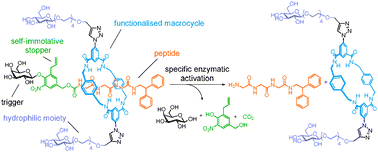Second generation specific-enzyme-activated rotaxane propeptides†
Abstract
A

* Corresponding authors
a
School of Chemistry, University of Edinburgh, The King's Buildings, West Mains Road, Edinburgh, UK
E-mail:
david.leigh@ed.ac.uk
Web: http://www.catenane.net
Fax: (+44) 131-650-6453
b
Université de Poitiers, UMR-CNRS 6514, Laboratoire de Synthèse et Réactivité des Substances Naturelles, 4 rue Michel Brunet, BP 633, 86022 Poitiers, France
E-mail:
sebastien.papot@univ-poitiers.fr
c
Centre de Biophysique Moléculaire, UPR 4301 CNRS, Rue Charles Sadron, 45071 Orléans, Cedex 2, France
E-mail:
aucagne@cnrs-orleans.fr
A

 Please wait while we load your content...
Something went wrong. Try again?
Please wait while we load your content...
Something went wrong. Try again?
A. Fernandes, A. Viterisi, V. Aucagne, D. A. Leigh and S. Papot, Chem. Commun., 2012, 48, 2083 DOI: 10.1039/C2CC17458H
To request permission to reproduce material from this article, please go to the Copyright Clearance Center request page.
If you are an author contributing to an RSC publication, you do not need to request permission provided correct acknowledgement is given.
If you are the author of this article, you do not need to request permission to reproduce figures and diagrams provided correct acknowledgement is given. If you want to reproduce the whole article in a third-party publication (excluding your thesis/dissertation for which permission is not required) please go to the Copyright Clearance Center request page.
Read more about how to correctly acknowledge RSC content.
 Fetching data from CrossRef.
Fetching data from CrossRef.
This may take some time to load.
Loading related content
